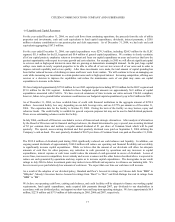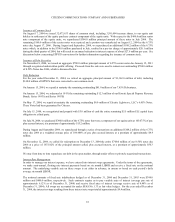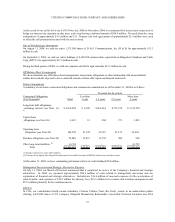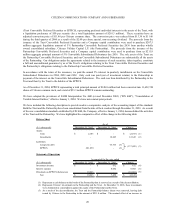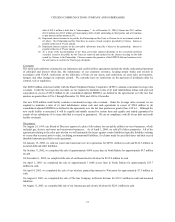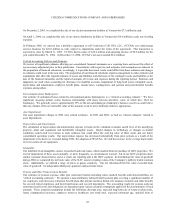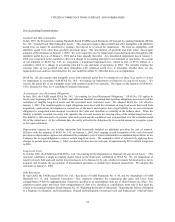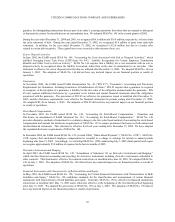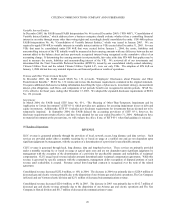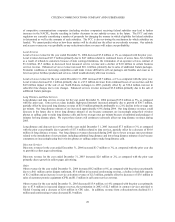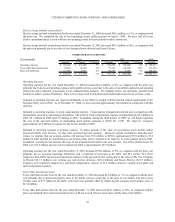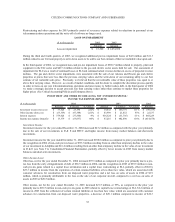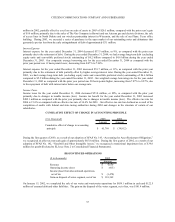Frontier Communications 2004 Annual Report Download - page 28
Download and view the complete annual report
Please find page 28 of the 2004 Frontier Communications annual report below. You can navigate through the pages in the report by either clicking on the pages listed below, or by using the keyword search tool below to find specific information within the annual report.
CITIZENS COMMUNICATIONS COMPANY AND SUBSIDIARIES
26
Variable Interest Entities
In December 2003, the FASB issued FASB Interpretation No. 46 (revised December 2003) (“FIN 46R”), “Consolidation of
Variable Interest Entities,” which addresses how a business enterprise should evaluate whether it has a controlling financial
interest in an entity through means other than voting rights and accordingly should consolidate the entity. FIN 46R replaces
FASB Interpretation No. 46, “Consolidation of Variable Interest Entities,” which was issued in January 2003. We are
required to apply FIN 46R to variable interests in variable interest entities or VIEs created after December 31, 2003. For any
VIEs that must be consolidated under FIN 46R that were created before January 1, 2004, the assets, liabilities and
noncontrolling interests of the VIE initially would be measured at their carrying amounts with any difference between the net
amount added to the balance sheet and any previously recognized interest being recognized as the cumulative effect of an
accounting change. If determining the carrying amounts is not practicable, fair value at the date FIN 46R first applies may be
used to measure the assets, liabilities and noncontrolling interest of the VIE. We reviewed all of our investments and
determined that the Trust Convertible Preferred Securities (EPPICS), issued by our consolidated wholly-owned subsidiary,
Citizens Utilities Trust and the related Citizens Utilities Capital L.P., were our only VIEs. The adoption of FIN 46R on
January 1, 2004 did not have any material impact on our financial position or results of operations.
Pension and Other Postretirement Benefits
In December 2003, the FASB issued SFAS No. 132 (revised), “Employers’ Disclosures about Pensions and Other
Postretirement Benefits.” SFAS No. 132 retains and revises the disclosure requirements contained in the original statement.
It requires additional disclosures including information describing the types of plan assets, investment strategy, measurement
date(s), plan obligations, cash flows, and components of net periodic benefit cost recognized in interim periods. SFAS No.
132 is effective for fiscal years ending after December 15, 2003. We adopted the expanded disclosure requirements of SFAS
No. 132 (revised).
Investments
In March 2004, the FASB issued EITF Issue No. 03-1, “The Meaning of Other-Than-Temporary Impairment and Its
Application to Certain Investments” (EITF 03-1) which provides new guidance for assessing impairment losses on debt and
equity investments. Additionally, EITF 03-1 includes new disclosure requirements for investments that are deemed not to be
temporarily impaired. In September 2004, the FASB delayed the accounting provisions of EITF 03-1; however, the
disclosure requirements remain effective and have been adopted for our year ended December 31, 2004. Although we have
no material investments at the present time, we will evaluate the effect, if any, of EITF 03-1 when final guidance is released.
(b) Results of Operations
REVENUE
ILEC revenue is generated primarily through the provision of local, network access, long distance and data services. Such
services are provided under either a monthly recurring fee or based on usage at a tariffed rate and are not dependent upon
significant judgments by management, with the exception of a determination of a provision for uncollectible amounts.
CLEC revenue is generated through local, long distance, data and long-haul services. These services are primarily provided
under a monthly recurring fee or based on usage at agreed upon rates and are not dependent upon significant judgments by
management with the exception of the determination of a provision for uncollectible amounts and realizability of reciprocal
compensation. CLEC usage based revenue includes amounts determined under reciprocal compensation agreements. While this
revenue is governed by specific contracts with the counterparty, management defers recognition of disputed portions of such
revenue until realizability is assured. Revenue earned from long-haul contracts is recognized over the term of the related
agreement.
Consolidated revenue decreased $252.0 million, or 10% in 2004. The decrease in 2004 was primarily due to $228.9 million of
decreased gas and electric revenue primarily due to the disposition of our Arizona gas and electric operations, The Gas Company
in Hawaii and our Vermont electric division and $23.1 million of decreased telecommunications revenue.
Consolidated revenue decreased $224.4 million, or 8% in 2003. The decrease in 2003 was primarily due to $192.7 million of
decreased gas and electric revenue primarily due to the disposition of our Arizona gas and electric operations and The Gas
Company in Hawaii division and $31.7 million of decreased telecommunications revenue.



